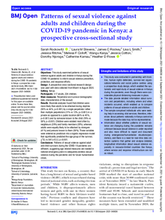This study was conducted in partnership with frontline, human rights defenders, survivor-led organisations/networks and social justice centres using a prospective study design, which enabled the systematic and rapid study of sexual violence in Kenya during the pandemic, even though there were considerable physical distancing measures in place.
The data provide detailed information about survivors and perpetrators, including where and when incidents occurred, which enabled us to compare patterns of sexual violence in adults and children.
The sample comprised individuals who were seeking help in accessing vital services; therefore, inferences about patterns nationally in Kenya cannot be made because the data may not be representative.
Information about whether patterns of sexual violence are changing during the pandemic remains unknown because sexual violence is under-reported and also more difficult to report and document during emergencies/humanitarian situations/pandemics, and there is a need for real-time data collection systems that gather and analyse detailed, longitudinal information about sexual violence especially in resource-limited countries like Kenya, where service and response infrastructure are not as robust.

